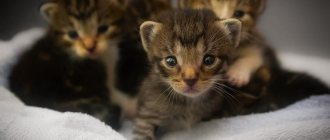Every responsible owner approaches the health of his furry pet with particular seriousness. Understanding that this factor is largely determined by several factors, the owner tries to create the most suitable conditions so that the development of kittens corresponds to all normal indicators. These include proper nutrition, the home conditions in which the animal lives, the presence of other pets in the house, and so on.
Why monitor the development of newborn kittens?
Knowing how a kitten grows and what skills it should acquire by a specific age, you can monitor your own pet. If you notice a deviation from the norm in any indicators in time, it is quite possible to eliminate it in the early stages of the problem.
The stages of growth and development of furry babies, from the moment of birth to one year, are associated with certain patterns. At the same time, each kitten is individual in its own way. Despite the fact that they go through the same stages of growing up, day by day and month by month. But they are all so different that it is impossible not to notice it even among the offspring of the same mother cat.
So, it should be noted that the first three months of a kitten’s life pass quite quickly for him. He is growing up quickly and gaining weight. This period is decisive in its further existence and development. Having overcome a kind of “critical” age threshold, most likely, everything will be fine in the future.
What should owners be wary of?
Care and attention are the most important things kittens need at this age. It is important not to miss the following points in the condition of a kitten up to 3 months:
- does not gain weight well;
- sleeps separately from the nursing cat and the rest of the litter of kittens;
- looks noticeably weaker than them;
- his mother ignores him;
- the kitten often experiences vomiting and diarrhea;
- discharge from the eyes, nose, anus.
If kittens have at least one of the above signs of pathology, they must be urgently shown to a specialist.
How does a kitten develop?
The kitten is born blind and helpless, but after six months he becomes an active and agile teenager, a small but well-armed predator with strong instincts that help him avoid danger and survive in a complex and unpredictable world. This magical transformation occurs according to certain laws: each new stage of life comes in its own time and leaves its mark on the character of the maturing cat.
This material has been prepared on the basis of many years of observations and serious research in the field of behavior problems in pets. We think that the facts that we present will help breeders properly organize the raising of kittens in nurseries, will provide valuable information to people with little experience, but who want to raise healthy and socially adapted kittens of their domestic cat, and will also teach everyone who wants to have a kitten to ask the right questions to the breeder and understand whether the baby grew up correctly in the nursery.
First month
The first month of a cat’s life can be compared to the first year of a child’s life [7]. The kitten goes from complete dependence on its mother to partial independence. By the end of this period, he is able to establish first contacts with the outside world. Some kittens open their eyes already on the second day after birth, others only on the 16th. Most often this occurs at one week of age. Kittens kept in a dark place open their eyes earlier than those raised in the light. A one-week-old kitten is already trying to walk - at first clumsily and cautiously, but after another two weeks he achieves mastery in this simple activity. By the end of the first month of life, the kitten begins to run [1].
During this period, the most important thing for him is his relationship with his mother. Brothers and sisters are now just competitors for food. The mother feeds and warms the kitten, and also helps it defecate by licking its tummy and the area around the anus. By the third week, the kitten learns to recover on its own, but the cat continues to help him until about 5 weeks of age [2].
A caring, calm, people-friendly mother is the key to the timely development and good character of the kitten. She teaches the kitten and punishes it by holding it with her back paw or hitting it on the nose with her front paw if he bites her too hard while flirting. Orphan kittens that are artificially fed have less control over their actions and may subsequently accidentally cause pain to their kitten or owner [4].
For the first three weeks of life, kittens receive only milk from their mother cat. In the fourth week, babies begin to get acquainted with “adult” food. If a cat is hunting, at this time she begins to bring prey to the nest, and the kittens remember the sight and smell of the prey. During this period, the cat is not constantly near the kittens, but prefers to watch them from a distance [1]. Regarding feeding, her tactics are also changing: she stops more and more often
not far from the kittens and waits for them to come up on their own.
If a cat's movements are limited, for example, by keeping her in a cramped cage with her cubs, the kittens begin to pester the cat with games. Her attitude towards them becomes less tolerant, and the kittens, imitating their mother in everything, also begin to play with each other more aggressively. Subsequently, this behavior is reinforced and becomes a character trait.
Second month
By the second month of life, the kitten becomes even more independent and leaves the nest for the first time. His communication skills are improving: he begins to communicate more and more with other kittens. During this period of life, he, in fact, turns into a representative of his species - he learns to communicate and hunt.
Towards the end of the first - beginning of the second month of life, kittens begin to play with each other. Gradually, the games become longer and longer and by the second month they turn into the cubs’ favorite pastime. In the game, they train their communication skills with their relatives and learn to understand the language of their species. During this period, kittens become strongly attached to their brothers and sisters. If a cat has only one kitten, it grows up more independent and is not afraid to be left alone. When there are several kittens, they behave more timidly: they are afraid to be alone and try to stay together.
Despite its importance for a child’s development, playing with relatives does not replace playing with objects, which should also have its place in his life. This is a completely special type of game - it helps to develop coordination of movements and a sense of space. In nature, these skills were necessary for a small predator to hunt [3].
Anyone who has newborn kittens in their home should know that at the age of two to seven weeks, babies go through a period of socialization, and humans are responsible for this process. At this time, the kitten needs to get acquainted with everything that will surround him in his later life [5]. Despite the fact that this period of socialization in cats is very short - much shorter than, for example, in dogs - it is especially “critical”. If the kitten spends these weeks in a poor, boring environment, without interacting with other cats or people, then it will be almost impossible to fill the gap in its development later.
Around the 7th week of life, kittens begin to perceive information about their relatives by the smell they leave behind. They carefully study the urine marks of other cats. At the same time, the “flehmen” reaction develops, when the kitten opens its mouth and wrinkles its nose. At this point, he analyzes the smell of urine using the vomeronasal organ, located inside the palate, which allows cats to learn about the maturity, readiness for mating, approximate age and health of their relative who left the mark [2].
From 2 to 6 months
Every day the kitten becomes more and more independent, and now the mother brings them half-dead prey for the first time. The sight of a prey running away makes a kitten
instinctive reaction - he jumps on a mouse or bird, but cannot always kill them. Then the mother intervenes. By imitating her and each other, the kittens learn everything that a predator should be able to do [3]. By 4 months they already accompany their mother on hunting trips.
From 6 months to a year
Adult cats perceive a six-month-old kitten as a teenager and, if they themselves had good social experience in childhood, treat him quite tolerantly. With the onset of puberty, the kitten moves from being an adolescent to the category of a young adult, and the attitude of its relatives towards it changes accordingly.
6–12 months of age is the age of separation from the mother and dispersal in young cats. A mother cat can maintain a friendly attitude towards her grown-up daughter for quite a long time and even show maternal care. She begins to reject her six-month-old son. In nature, this prevents inbreeding. However, if the space in which cats live is limited, and the son has nowhere to go, gradually the cat’s anger again gives way to mercy, and she can bring offspring from her son. In nature, this does not happen, since a young cat has to compete with older and battle-hardened males, and he begins breeding later, when he reaches not only sexual, but also mental maturity.
Nutrition
Insufficient nutrition of a cat in the second month of pregnancy and in the first weeks after birth, namely a lack of protein food, leads to a delay in the development of kittens: they open their eyes later, later they begin to crawl, run, play with relatives, poor coordination of movements prevents the development of hunting and play behavior , and all these disorders generally lead to difficulties in communicating with relatives [2].
Kittens grow up fearful and aggressive, it is difficult for them to get used to changes, any unexpected event plunges them into a state of shock [6]. Those who pick up a kitten on the street should be aware of these behavioral difficulties. Raising him to be a good companion may require more effort than with a domestic cat kitten. Interestingly, kittens aged 2–6 months easily imitate not only their mother and other cats, but also dogs if they live in the same house with them. They may try to accompany the owner and even learn some commands. It looks fantastic. I once trained a Yorkshire terrier puppy, teaching him for 20 minutes to come on command and sit at his owner's left leg. The young cat hung around all the time, trying to steal pieces of chicken that were used to reward the puppy. Having failed, the cat waited for the moment when the puppy did not comply with the command, jumped onto the floor, ran up to the owner and sat down exactly at her leg, like a well-trained shepherd dog. Need I say that he immediately received the desired delicacy?
Insulation
As we have already said, isolating a kitten at an early age leads to irreversible consequences. If a kitten is taken from its mother in the first days after birth, it grows up to be more aggressive. Lack of communication with relatives before 7 months leads to the development of fear of them, which will be all the more difficult to overcome, the more limited the kitten’s childhood experience. Isolation of a kitten from birth to one year has a negative effect on its nervous system; its rhythm of sleep and wakefulness is disrupted.
If a kitten is taken from its mother in the third or fourth week of life, that is, before it naturally and gradually begins to eat solid food, its hunting behavior will develop earlier and more strongly than usual. The same thing happens with orphaned kittens who are fed from a nipple.
Innate tendencies
A kitten's developing character is influenced by genetic predisposition, the conditions in which its mother cat was pregnant, and then the conditions in which the cub spent the first months of its life. According to their innate inclinations, cats can be divided into three groups: timid, aggressive and sociable [2]. These basic properties can be strengthened or weakened only to a certain extent, they remain the background for all subsequent layers of experience in the kitten's life.
Table of correspondence between the ages of cats and people
| Age of human kitten |
| 0–1 month 0–1 year |
| 2–3 months 2–4 years |
| 4 months 6–8 years |
| 6 months 10 years |
| 7 months 12 years |
| 12 months 15 years |
| 18 months 21 years old |
| 2 years 24 years |
References:
1. Crouwell-Davies S. Social behavior, communication and behavioral development in cats / Guide to behavioral medicine in dogs and cats. M.: Sofion, 2005
2. Overol K. Clinical methods for correcting the behavior of dogs and cats. M.: Sofion, 2005.
3. Caro TM Predatory behavior and social play in kittens // Behavior. 1981. V. 76, N?, 1-24
4. Casey RA, Bradshaw JWS The effects of additional socialization for kittens in a rescue center on their behavior and suitability as a pet // Applied Animal Behavior Science. 2008. V. 114, 196–205
5. Frank D., Dehasse J. Differential Diagnosis and Management of Human-Directed Aggression in Cats // Veterinary Clinics of North America: Small Animal Practice. 2003. V. 33, N 2, 269-286
6. Karsh EB: The effects of early handling on the development of social bonds between cats and people, in Katcher AH, Beck AM, (eds): New perspectives on our lives with companion animals. Philadelphia, University of Pennsylvania Press. 1983. 22-28
7. Reisner IR, Houpt KA, Erb HN, Quimby FW Friendliness to Humans and Defensive Aggression in Cats: The Influence of Handling and Paternity // Physiology & Behavior. 1994. V. 55, N6, 1119-1124
8. Vogt AH, Rodan I., Brown M., Brown S., Buffington CAT, Forman MJL, Neilson J., Sparkes A., Feline life stage guidelines // Journal of Feline Medicine and Surgery. 2010. V. 12, 43-54
The article was published in the magazine “My Friend Cat” No. 3, 2011
Thanks for the repost!











